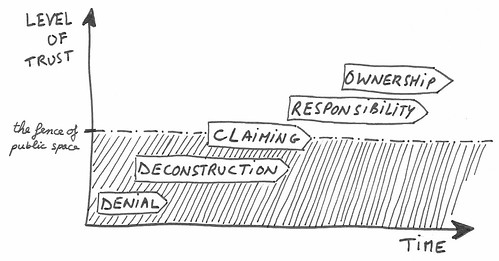Have you ever tried to make someone in your organization the owner of a project or an initiative? How about propelling someone into a new position? Ownership is the road less traveled.
In my experience the failure rate of those endeavors is quite high. This is because we fail to see ownership for what it is: a process instead of a switch. Unfortunately accepting that ownership is a process is not a guarantee that it will work. There are many pitfalls along the road.
Ground Zero
The first reaction you are most likely to meet is denial. Denial has many faces. Examples include:
- No;
- Up yours;
- Over my dead body;
- Not in a lifetime;
- Not in my backyard;
- Who do you think you are?;
- Been there, done that, doesn’t work.
It’s no wonder that this first phase is one of denial. This is common ground for many developments involving human beings. Organizational change practitioners can show you tons of literature ranging from early child psychologists (Jean Piaget), studies on death and dying (Elisabeth Kuebler Ross), insights on burning platforms (Daryl Conner), to the latest findings on positive psychology (Jonathan Haidt) and an analysis of how you put it all to practice (the Heath brothers).
The Dip of Ownership
The next phase you are likely to meet is deconstruction. The alleged owner of your project or initiative will now take it all apart in an attempt to fully understand what it is all about. Although this is a very healthy indication of future ownership, chances are you will be hooked by the fallacy of resistance.
The fallacy of resistance occurs whenever we label this behavior as ‘resistance’ and pull our guns. Most of the times we will be tempted to respond with more control and discipline. And this is exactly the opposite of what is needed when people are coming to terms with their new identity.
It’s like opening the oven too early when baking bread. There is no better way to make the bread collapse. The worst part is that we you will probably react along the lines of: ‘You see, I told you the bread would collapse.’

Just when you thought you had it all, reality hits you with another with another kick in the butt. We are in the dip of ownership. The only way to get out of that dip is by increasing the level of trust – also on the public level.
Crossing the Fence
Even when you realize that controlling and sanctioning will evaporate all the investments of time, manpower and money in a split second, you could use some help in navigating the situation.
We are now in the next phase; the phase of claiming. After deconstructing the components of the initiative, the future owner will now start to claim the initiative. The mechanics of this phase are simple: after denying and deconstructing, the future owner is now confronting her new identity with the world. The future owner is now crossing the fence of public space. They will either step in with both feet or run like hell.
This is when you will need to step back and allow even more trust. There is a great risk that you will not have the maturity yourself to let this happen because – most of the times – this is a messy phase (it’s called learning) and you will be tempted to ‘rescue’ the person claiming the ownership.
My advice: don’t.
Able to Respond
The next phase is the one of responsibility. It’s the final test before ownership. When people claim something in a space, chances are the space responds with feedback. This is the time for owners to mature and interact with the reactions they receive on their new identity.
Responsibility is a self-regulating mechanism. Everything becomes clear when we study the English definition for “responsible”: It literally means “able to respond” or “being capable of responding.” When people choose to take responsibility in a situation, they co-own it.
The propulsion of this mechanism provides a last filter before arriving at the destination. Responsibility touches the soul. If the new identity resonates with the owner’s soul they will make it. Else, well… they will break. (Note: there is nothing wrong with ‘breaking’. It’s a neutral fact; a confirmation that this identity is not who she wants to be.)
The Destination
Finally, we have arrived at the stage where the owner is pulling her own weight. Ownership is the word. It’s a process. Most of all: it’s the road less traveled.







